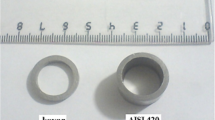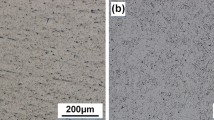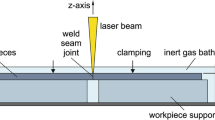Abstract
Incompatibilities of thermo-physical-mechanical as well as metallurgic properties between dissimilar Ti and Ni metals present technical challenges to their fusion joining. In this manuscript, using a high power continuous wave (CW) YAG laser, a direct butt welding of Ti and Ni plates was performed with a relatively large beam offset from the contact interface between two base metals (BMs) toward either side of the BMs. As a result, a large amount of rapidly solidified non-equilibrium solid solution occurred in the main fusion zone (FZ); while the total amount of prior intermetallic compounds (IMCs) such as Ti2Ni, Ni3Ti and NiTi significantly decreased, most of which were primarily located as a band (less than 200 μm wide) along one of the fusion interfaces with the BMs. When the laser beam was shifted 0.5 mm toward the Ni side, the toughness of the FZ was sufficiently improved, leading to a crack-free joint. In this study, the microstructures, chemical compositions, and microhardness in the laser-welds thus obtained were examined to learn the influences of beam offset on laser weldability of Ti to Ni metals.















Similar content being viewed by others
References
Gobbi SL et al (1996) Laser welding of superalloys and of titanium alloys, Synthesis Report for Publication (Project No. P4096-90), RTM Instituto per le Ricerche di Tecnologia Meccanica e per l’Automazione; 10080 Vito Canavese, Torino, Italy
Chen HC, Pinkerton AJ, Li L (2011) Fibre laser welding of dissimilar alloys of Ti-6Al-4V and Inconel 718 for aerospace applications. Int J Adv Manuf Technol 52:977–987
Cai Q, Liu W, Ma Y, Wang Z (2015) Diffusion brazing of tungsten and steel using Ti–Ni liquid phase forming interlayer. Fusion Eng Des 91:67–72
Seretsky J, Ryba ER (1976) Laser welding of dissimilar metals: titanium to nickel, metallurgical study shows why Ti to Ni joints were unsuccessful by laser welding. Weld J Res Suppl 55:S208–S212
Chatterjee S (2006) Microstructure development during laser and electron beam welding of Ti/Ni dissimilar joints, Ph.D thesis, Indian Institute of Science, Bangalore, India
Otsuka K, Ren X (2005) Physical metallurgy of Ti–Ni-based shape memory alloys. Prog Mater Sci 50:511–678
Baker H (1992) Alloy phase diagrams, ASM handbook, v.3. ASM International, Materials Park, p 2–319
Gan Z, Yu G, He X, Li S (2017) Numerical simulation of thermal behavior and multicomponent mass transfer in direct laser deposition of co-based on steel. Int J Heat Mass Transf 104:28–38
Wolff SJ, Gan Z, Lin S, Bennett JL, Yan W, Hyatt G, Ehmann KF, Wagner GJ, Liu WK, Cao J (2019) Experimentally validated prediction of thermal history and microhardness in laser-deposited Inconel 718 on carbon steel. Addit Manuf 27:540–551
Miranda RM, Assunção E, Silva RJC, Oliveira JP, Quintino L (2015) Fiber laser welding of NiTi to Ti-6Al-4V. Int J Adv Manuf Technol 81:1533–1538
Sun Z, Ion JC (1995) Review: laser welding of dissimilar metal combinations. J Mater Sci 30:4205–4214
Sun Z, Karppi R (1996) The application of electron beam welding for the joining of dissimilar metals: an overview. J Mater Process Technol 59:257–267
Shanmugarajan B, Padmanabham G (2012) Fusion welding studies using laser on Ti-SS dissimilar combination. Opt Lasers Eng 50:1621–1627
Chen J, Khalifa A, Xue L, King M (2018) Laser weldability of Zr-2.5Nb alloy to AISI 410 stainless steel with Ni filler. J Mater Process Technol 255:184–194
Wang T, Zhang B, Feng J (2014) Influences of different filler metals on electron beam welding of titanium alloy to stainless steel. Trans Nonferrous Metals Soc China 24:108–114
Mohid' Z, Liman MA, Rahman' MRA, Rafai NH, Rahim EA (2014) Dissimilar materials laser welding characteristics of stainless steel and titanium alloy. Appl Mech Mater 465(466):1060–1064
Möller F, Grden M, Thomy C, Vollertsen F (2011) Combined laser beam welding & brazing process for aluminum titanium hybrid structures. Phys Procedia 12:215–223
Zhang MJ, Chen GY, Zhang Y, Wu KR (2013) Research on microstructure & mechanical properties of laser keyhole welding-brazing of automotive galvanized steel to aluminum alloy. Mater Des 45:24–30
Kabir ASH, Cao X, Medraj M, Wanjara P, Cuddy J, Birur A (2010) Effect of welding speed and defocusing distance on the quality of laser welded Ti-6Al-4V. In Laser Applications in Materials Processing, Materials Science & Technology (MS&T) 2010 Conference and Exhibition, Oct. 17-21, Houston, TX, pp.2787–2797.
Royal Chemical Society, http://www.rsc.org/periodic-table/element
AZO Materials, https://www.azom.com
MatWeb, Material property Data, http://www.matweb.com
Blodgett OW, Funderburk RS, Miller DK, Quintana M (1999) Fabrications’ and Erectors’ Guide to Welded Steel Construction, The James F. Lincoln Arc Welding Foundation, pp.40–44, http://www.jflf.org/v/vspfiles/assets/pdf/fabguide.pdf
Li HM, Sun DQ, Wang WQ, Han YW, Gu XY (2010) Effects of laser welding parameters on microstructure and mechanical properties of laser welded TiNi shape memory alloy (SMA) wires. Laser Eng 20:167–177
Gong X, Mohan S, Mendoza M, Gray A, Collins P, Kalidindi SR (2017) High throughput assays for additively manufactured Ti-Ni alloys based on compositional gradients and spherical indentation. Integr Mater Manuf Innov 6:218–228
Kim HT, Nam SW, Hwang SH (1996) Study on the solidification cracking behavior of high strength aluminum alloy welds: effects of alloying elements and solidification behaviors. J Mater Sci 31(11):2859–2864
Acknowledgments
The authors would like to thank Dr. A. Khalifa, CNL, Chalk River, for his participation of this work, and Mr. A. Kittmer, CNL, Chalk River, for the preparation of the metal plates for laser beam welding.
Author information
Authors and Affiliations
Corresponding author
Additional information
Publisher’s note
Springer Nature remains neutral with regard to jurisdictional claims in published maps and institutional affiliations.
Rights and permissions
About this article
Cite this article
Chen, J., Xue, L., King, M. et al. High power CW YAG laser weldability of dissimilar Ti to Ni metal plates through beam shift. Int J Adv Manuf Technol 104, 489–501 (2019). https://doi.org/10.1007/s00170-019-03870-4
Received:
Accepted:
Published:
Issue Date:
DOI: https://doi.org/10.1007/s00170-019-03870-4




